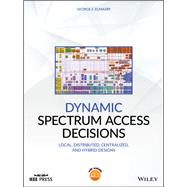Optimize your dynamic spectrum access approach using the latest applications and techniques
Dynamic Spectrum Access Decisions: Local, Distributed, Centralized and Hybrid Designs prepares engineers to build optimum communications systems by describing at the outset what type of spectrum sensing capabilities are needed. Meant for anyone who has a basic understanding of wireless communications and networks and an interest in the physical and MAC layers of communication systems, this book has a tremendous range of civilian and military applications.
Dynamic Spectrum Access Decisions provides fulsome discussions of cognitive radios and networks, but also DSA technologies that operate outside the context of cognitive radios. DSA has applications in:
- Licensed spectrum bands
- Unlicensed spectrum bands
- Civilian communications
- Military communications
Consisting of a set of techniques derived from network information theory and game theory, DSA improves the performance of communications networks. This book addresses advanced topics in this area and assumes basic knowledge of wireless communications.








